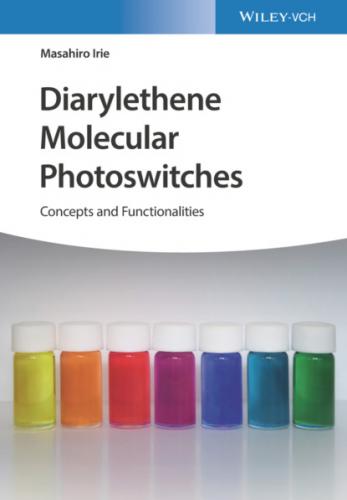A characteristic feature of molecules is their small size (∼ 1 nm). If a single molecule would work as one‐bit memory, ultimate high‐density (1 P bit/inch2) optical memory could be realized. Conductance switches are key components of almost all electronic devices. Fabrication of single‐molecule photoswitches is the first step toward molecular electronics. Photoswitching of single‐molecule fluorescence has revolutionized fluorescence microscopy imaging. The super‐resolution technique realizes a resolution of a few tens of nanometers. For such applications, molecular photoswitches are required to possess superior properties, such as thermal stability of both isomers, fatigue resistance, high sensitivity, rapid response, and reactivity in the solid state. Among them, thermal stability and fatigue resistance are indispensable properties. Although tremendous efforts were made in the 1970–1980s to provide the thermal irreversibility to molecular photoswitches in order to apply them to optical memory media, all attempts to modify existing photoswitchable molecules failed, because there was no guiding principle on how to prepare such thermally stable molecular photoswitches.
In 1988, the serendipitous discovery of diarylmaleic anhydrides, which undergo thermally irreversible photoswitching reactions, paved the way to solve the problem. Inferring from experimental as well as theoretical analysis, the molecular design principle of thermally irreversible molecular photoswitches was established. This new class of molecular photoswitches is named “Diarylethene.” The well‐designed diarylethenes provide outstanding photoswitching performance: both isomers are thermally stable for more than 470 000 years at 30 °C, photocyclization(coloration)/photocycloreversion(decoloration) can be repeated for more than 104 cycles, the quantum yield of cyclization reaction is close to 1 (100%), and the response times of both photocyclization and photocycloreversion reactions are less than 20 ps. Many of the diarylethene derivatives undergo photoswitching reactions even in the crystalline phase. In this book, the discovery and development of diarylethenes are described comprehensively from the basic concepts to their applications.
I wish to express my deep appreciation to my colleagues, Prof. M. Morimoto, Prof. S. Kobatake, Prof. K. Matsuda, Prof. T. Fukaminato, Prof. K. Uchida, Prof. T. Kawai, Prof. T. Tsujioka, and Dr. K. Uno for their kind help and support to prepare the manuscript. Finally, I also express my thanks to my family, Setsuko, Fumi, and Hisafumi for their continual encouragement to complete this book.
December 2020
Masahiro Irie
1 Introduction
1.1 General Introduction
Biological systems have developed various kinds of photoactive organs to adapt themselves to environmental electromagnetic radiation, sunlight. In biological systems, light is used in two ways as shown in Figure 1.1. In plants, for example, photosynthetic systems have evolved to utilize light as an energy source. Carbohydrates are produced from water and carbon dioxide in plants by using light as an energy source. Another category is the use of light for information access and transmission. Light is used to seek out optimum conditions for their life. Photoresponsive biological systems for vision, phototaxis, and phototropism have evolved to recognize surrounding conditions and to access external information. In the former, photoinduced electron transfer is a key chemical reaction. On the other hand, photoisomerization plays a key role in the latter.
Figure 1.1 The use of light in biological systems.
Photoisomerization is one of the fundamental reactions in photochemistry [1–3]. Trans–cis isomerization, sigmatropic rearrangements, and electrocyclic rearrangements are typical examples. Molecules capable of these reversible photoisomerization reactions are called photochromic molecules or molecular photoswitches [4–10]. The two isomers differ from each other not only in their absorption and fluorescence spectra but also in their geometrical structures, oxidation/reduction potentials, refractive indices, and dielectric constants.
Scheme 1.1 shows typical examples of photoswitchable molecules and when they were discovered. The three upper molecules, azobenzene [11], spirobenzopyran [12], and bridged imidazole dimer [13], belong to T‐type (thermally reversible) molecular photswitches, in which photogenerated right‐side colored isomers are thermally unstable and spontaneously revert back to left‐side colorless isomers in the dark. Azobenzene undergoes a large change in geometrical structure during the photoisomerization reaction from the trans‐ to the cis‐form. The distance between 4 and 4′ carbon atoms (the long axis of the molecule) decreases from 0.90 to 0.55 nm and the dipole moment increases from 0.5 to 3.1 D [14, 15]. A spirobenzopyran derivative, 6‐nitro‐1′,3′,3′‐trimethylspiro[2H‐1‐benzopyran‐2,2′‐indoline], converts from a less polar spiro‐form to a polar merocyanine‐form upon irradiation with UV light. It is reported that the dipole moment of the spiro‐form is 6.2 D, while it increases to 13.9 D in the merocyanine form [16]. The blue color of the merocyanine form disappears in less than an hour even in high‐Tg polymer matrices in the dark at room temperature [17]. A colorless bridged imidazole dimer, 1,8‐TPID‐naphthalene (TPID: dimer of triphenylimidazolyl radicals), turns green in toluene upon irradiation with UV light, and the green color disappears in less than a few seconds after switching off the UV light [18]. The imidazole dimer exhibits extremely quick response.
Scheme 1.1 Molecular photoswitches and years when they were discovered.
The two lower molecules, furylfulgide [19] and diarylethene [20–22], undergo P‐type (thermally irreversible but photochemically reversible) photoswitching reactions. In the P‐type molecular photoswitches, photogenerated right‐side colored isomers are thermally stable and practically never return to the right‐side colorless isomers in the dark at room temperature. Although many molecular photoswitches have been so far reported, P‐type chromophores are very rare. The families, furylfulgides and diarylethenes, are two such rare examples exhibiting P‐type reactivity. The primary difference between furylfulgides and diarylethenes is fatigue resistance. Photoinduced coloration/decoloration cycles of well‐designed diarylethene derivatives can be repeated more than 104 times maintaining adequate photoswitching ability (see Section 3.3), whereas in most cases the corresponding cycles of furylfulgides are limited to less than 102 times.
The instant property changes of photoswitchable molecules by photoirradiation without any additional process lead to their use in various photoresponsive materials and photonic devices. When the bistable molecules are incorporated into materials, the electronic structure changes can be applied to optical memory media and conductance
